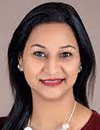Tutorial 2

Future Possibilities with Stretchable Electronics
Shweta Agarwala
Aarhus University
Abstract: Stretchable electronics is an emerging technology that creates devices with the ability to conform to nonplanar and dynamic surfaces such as the human body. Stretchable electronic devices are typically implemented in large-area, low-density, single-layer formats. However, these configurations limit the level of integration and functional complexity that can be achieved. Printed electronics, a category of 3D printing technique, is rapidly gaining attention due to its potential for creating next-generation devices that have stretchability. Printed electronics is indeed emerging as a transformative technology capable of impacting areas from consumer electronics, wearables, healthcare to automobiles. This tutorial will provide an overview of the printed electronics landscape by discussing the technology, materials, processes and applications. The contents can be roughly summarized as follows:
- Introduction and principles of stretchable electronics
- Drop-on-demand technologies for printed electronics
- Materials and functional inks
- Case studies from speaker's research group
- Impact and potential application of the technology
- Challenges to the field and ways to overcome them
Biography: Dr. Shweta Agarwala got her B.Tech in Electronics & Communication Engineering from M. J. P. Rohilkhand University, India. She pursued her M.Sc from Nanyang Technological University (NTU), Singapore with specialization in microelectronics. She obtained her Ph.D in 2012 from National University of Singapore (NUS) on 'nanostructured materials for dye-sensitized solar cells'. She joined Energy Research Institute, Singapore as post-doctoral researcher and worked on building library of lead-free and lead based perovskite materials. Later she joined Singapore Center for 3D Printing, Singapore to engage in printed electronics research.
Currently, she is a pursuing her research on direct-write and 3D printing methods for flexible electronics, bioelectronics and bioprinting at Department of Engineering, Aarhus University, Denmark. Her research is multidisciplinary with applications in flexible devices, wearables, smart packaging and healthcare. Through her research, she is trying to understand interaction of electronic inks on unconventional substrates like paper, textiles, polymers, medical plasters and biomaterials.
She is IEEE senior member and Vice-chair of Women in Engineering affinity group, Denmark section, IEEE. Outside work she is a STEM advocate, avid reader and fitness enthusiast.